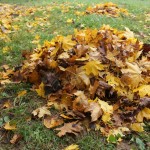 As we head into the second week of October, we start seeing the effects of beginning to hit: cooler weather, leaves turning brilliant colors, and pumpkin spice lattes. But pretty soon it will be winter, with the leaves gone, the cold wind blowing, and, if last winter was any indication, your lawn covered with snow. Here are our tips for preparing your lawn for Winter.
As we head into the second week of October, we start seeing the effects of beginning to hit: cooler weather, leaves turning brilliant colors, and pumpkin spice lattes. But pretty soon it will be winter, with the leaves gone, the cold wind blowing, and, if last winter was any indication, your lawn covered with snow. Here are our tips for preparing your lawn for Winter.
To ensure your lawn is prepared to hibernate during the winter months and grow healthy in the spring, there are several steps you can take right now. Here are our 6 tips for preparing your lawn for winter:
1. Evaluate your lawn
Evaluate your lawn conditions coming out of summer-look for problems that may need addressed such as broadleaf weeds or thin and bare areas. A summer such as this year has taken a toll on southcentral PA lawns and lawn renovation could benefit greatly. Fall is the best time to get control of many of the stubborn weeds we see throughout the summer. Seeding your lawn with a high quality grass seed can help fill in some of the areas damaged by summer drought, disease, and insects.
2. Pick up leaves
 It is important to keep up on leaf pickup during the fall and into winter. To most people this is not a fun job but necessary to keep leaves from smothering grass over the winter. Mulching the leaves regularly will keep debris small and allow you to keep from raking; however, in heavy leaf drop locations some pickup may be necessary to keep leaves from becoming a huge mess to deal with. Smothering leaves can also promote disease issues to deal with later on.
It is important to keep up on leaf pickup during the fall and into winter. To most people this is not a fun job but necessary to keep leaves from smothering grass over the winter. Mulching the leaves regularly will keep debris small and allow you to keep from raking; however, in heavy leaf drop locations some pickup may be necessary to keep leaves from becoming a huge mess to deal with. Smothering leaves can also promote disease issues to deal with later on.
3. Continue mowing
Just because turf growth slows heading into winter, it is still important to mow at proper intervals. You may gradually drop your mowing height as you phase out mowing all together. The shorter turf will minimize outbreaks of snow mold that favor higher, matted down grass. Be sure not to put the mower away too early and pay attention to the growth of the grass. Once mowing is done be sure to have mower properly serviced for the next season.
4. Fall fertilization
Fall is arguably the best time to fertilize one’s lawn. The grass will be reserving energy to store for the winter. A proper late fall fertilizer will provide essential nutrients for the turf and provide a stronger root system without causing rapid growth. A good fall/winter fertilization will also allow for a nice green lawn in the springtime.
5. Aeration
 Core aeration is often overlooked as a major contributor to turf health. This practice of mechanically pulling “plugs” of soil from the ground can relieve oxygen depriving compaction, allowing for improvement in air, water, and to get down into the soil and root system. Core aeration, recommended by the experts such as Penn State University, will go a long way into the long care health of your lawn. Combined with the spread of grass seed after core aerating will provide a better yield of grass as well as the seed falls into the holes left by the aerator.
Core aeration is often overlooked as a major contributor to turf health. This practice of mechanically pulling “plugs” of soil from the ground can relieve oxygen depriving compaction, allowing for improvement in air, water, and to get down into the soil and root system. Core aeration, recommended by the experts such as Penn State University, will go a long way into the long care health of your lawn. Combined with the spread of grass seed after core aerating will provide a better yield of grass as well as the seed falls into the holes left by the aerator.
6. Call a professional
If you have lawn struggles, as likely was the case this year, then there may be some issues that need extra attention. Perhaps a soil test may also indicate soil deficiencies that may need addressed. Grass is not just grass so your situation may be totally different from your neighbors. Allow a professional company like Tomlinson Bomberger to assist you in all of your lawn care needs.

